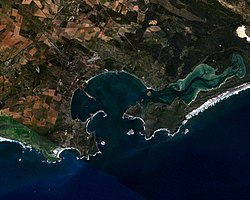Surrender in Saldanha Bay
| date | 16th bis 17th August 1796 |
|---|---|
| place | Saldanha , Cape Colony |
| output | Dutch surrender |
| consequences | Loss of the Cape Colony |
| Parties to the conflict | |
|---|---|
| Commander | |
| Troop strength | |
| 3 ships of the line, 3 frigates, 3 smaller ships |
13 ships of the line and frigates |
| losses | |
|
9 ships |
|

With the capitulation in Saldanhabucht in August 1796, the Dutch attempt to recapture the Cape Colony , which had been lost to the British the previous year, failed. The Dutch fleet anchored in Saldanhabucht surrendered to the British Royal Navy without a fight .
initial situation
Already during the parallel to the American War of Independence running the Fourth Anglo-Dutch War , there had been 1781 a naval battle between the British and Dutch in the Saldanhabucht, and already during this war an internal split in the Dutch Admiralty and the officer corps had prevented an energetic sea warfare. A large part of the admirals supported the nobility party of the Dutch inheritance holder Wilhelm V from the House of Orange ; the Orangists ( orangists ) were pro-British. The opponents of the oligarchical and corrupt rule of the Orange, who came to a lesser extent also from the nobility, but mainly from the urban bourgeoisie, described themselves as “ patriots ” and were more republican, democratic and pro-French.
Orange against patriots
The outrage over the peace agreement with Great Britain, which was disadvantageous for the Netherlands, culminated in an uprising against the Orange in Hattem and Elburg in Gelderland in 1786 , and Utrecht and Holland also fell away from the Orange. However, while Prussia intervened militarily in favor of the overthrown Orange, the patriots were initially defeated in 1787 in view of the lack of French help.
The patriots who fled to France formed exiled legions there, which together with French revolutionary troops occupied the Netherlands in January 1795 and proclaimed the Batavian Republic . The again overthrown inheritance holder fled to Great Britain and authorized the British to occupy at least the Dutch overseas colonies and to administer them in his name. He called on the Dutch governors to surrender to the British.
Power struggle in the Cape Colony
In the South African Cape Colony , there were then clashes between the Orange and patriots, but also between patriotic settlers and the Dutch East India Company . British troops landed and occupied the colony. In contrast, the patriots had founded Batavian subsidiary republics in Swellendam and Graaf-Reinet in February 1795 , but Swellendam was subjugated in June, and in September 1795 the Dutch governor capitulated in Cape Town.
At least in the Graaff-Reinet Republic , however, the patriots were initially able to assert themselves against the Orange and British. Urged by the protective power of France and relying on the support of the local patriots, the Batavian Republic dispatched a Dutch fleet and a small expeditionary force to recapture the Cape Colony in March 1796.
Mutiny instead of sea battle
The Dutch Rear Admiral Engelbertus Lucas anchored in Saldanhabucht on August 6, 1796 with nine warships and 2,000 marines . However, he remained inactive or was busy with repairs and sickness until British troops under General James Henry Craig occupied the city of Saldanha on August 14th . On August 16, a superior British fleet appeared under Vice Admiral George Elphinstone and included the Dutch squadron in the bay.
On August 17, Lucas and his officers accepted the British invitation to surrender and surrendered the nine Dutch ships without a fight. Before a Dutch court martial, Lucas tried to justify himself in 1797 by stating that an Orange-inspired mutiny had broken out on the ships and made resistance impossible. In fact, a patriotic mutiny against the surrender broke out on some ships, which was only suppressed by the British.
consequences
With no prospect of help from home, the Graaff-Reinet republic surrendered on August 22, 1796. The entire Cape Colony was then under the control of the British and their Orange allies.
literature
- Pierer's Universal Lexicon , Volume 6, Page 655 . Altenburg 1858
- Pierer's Universal Lexicon , Volume 11, Page 909 . Altenburg 1860
- Aria Johannes Knock: Uit Lievde voor Vaderland en Vrijheid. Het journaal van de patriot Arie Johannes Knock over de periode 1784 tot 1797. Uitgeverij Verloren, Hilversum 1994, ISBN 90-6550-125-8 . (Diary of a participant, Dutch)
Web link
- Royal Navy website: Handover of the Dutch squadron to the British in Saldanhabucht ( Memento of March 28, 2014 in the Internet Archive ) (Dutch)




